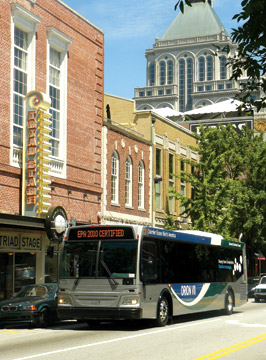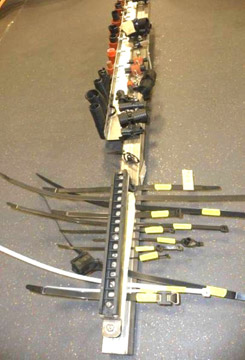Daimler Buses North America introduces the Orion VII Transit Bus for 2010
By David Hubbard
Sometimes it is okay if important changes are not so noticeable. At least this is the case for alterations made to the 2010 Orion VII transit bus by Daimler Buses North America (DBNA), Greensboro, NC. The next iteration made its debut in Cleveland, OH, in May during the American Public Transportation Association (APTA) Bus & Paratransit Conference.
The major changes incorporate all the necessary updates to fully comply with the 2010 Environmental Protection Agency (EPA) emission standards. Beyond the mandate, DBNA made additional design and structural enhancements for greater curb appeal and ease of maintenance. The most significant tweaks to the 2010 Orion VII will likely go unnoticed by the average transit passenger but the operators and technicians who maintain the fleet on a daily basis will certainly appreciate the alterations.
“We were fortunate in being able to share Daimler’s worldwide engineering resources as we prepared for the EPA 2010 emission standards,” says Patrick Scully, DBNA chief commercial officer. “We were able to adapt these international concepts to the updated Orion VII for North America. We went to great lengths to duty-cycle test this bus to make it as reliable as possible.”
Structural durability testing
He says DBNA built a total of seven test buses and put them through Daimler’s own structural durability testing. Engineers subjected the new vehicles to 60 tests at the company proving grounds and logged approximately 500,000 simulated miles that mimicked real life driving conditions.
The Orion VII features Selective Catalytic Reduction (SCR) technology to provide the cleanest possible NOx emission levels and to maximize fuel efficiency. The SCR method routes the exhaust from the engine through the after treatment system, in which the diesel particulate filter (DPF) scrubs the flow through the SCR filter to allow small doses of diesel emission fluid (DEF) to react to lower NOx emissions, leaving only the required level of exhaust gases to escape through the tailpipe.
Scully says any changes that could ease maintenance received key consideration as the team prioritized necessary upgrades. DBNA regional sales manager John Obert reports the efforts did not go unnoticed, noting that more than a few transit maintenance managers inspecting the bus during the conference thanked the company for making it easier to service many of the systems.
The makeover first considered mandatory requirements in addition to 2010 EPA requirements, which included new transmissions and moving the A/C unit to the roof to accommodate the placement of the DPF in the engine compartment.
Get more great articles like this one with a subscription to BusRide!
Click here to subscribe.
“From there we combed over the Orion VII to see where we could just make it better,” says Obert. “We improved the cooling system, made it easier to access and protect the batteries with a new tray, and developed a new driver’s barrier.”
Easier access
Redesigned and repositioned floor hatches allow easier access to electrical components and connections on the engine, transmission and hybrid drive system. Improved soundproofing reduces noise levels inside and out.
Obert says the most pronounced changes involved the reconfiguration and rerouting of the electrical wiring harnesses and the fully integrated engine cradle.
Standardization of clamping methods for all harnesses meant changing out bolt-mounted clamps to frame-welded slotted brackets and clamps with ties.
“Our design engineers on this project completely restructured the basic engine cradle to accommodate all three diesel, hybrid-electric or CNG propulsion systems in a nearly identical engine compartment,” he says. “This permits standardized installation of components, lines and electrical harnesses across all three modes with only minimal modifications.
Obert adds this major innovation also opens up considerably more space at the rear deck for troubleshooting. It also removes the need in initial manufacturing to construct a separate frame and engine cradle for each engine type.
The Cummins ISB Diesel engine powers the hybrid model, the Cummins ISL fits the Diesel and the Cummins ISL-G runs the CNG model. All three operate with a common engine cooling fan drive system.
The ISL diesel engine offers ZF or Allison transmission options. The hybrid bus application features the BAE application and updated Modular Traction System.
Except for the roof covers for hybrid accessories, the exterior basically remains unchanged. However, customers have the option of a more streamlined, European-inspired, BRT-styled roofline as well as disc brakes on the 2010 Orion VII.
New floor hatches are a recommended inspection and service option. DBNA say they provide easier access to diesel and CNG transmission connections, and the traction motor on the hybrid model. The hatches provide easy access to disconnect the driveshaft for towing and all engine mounts are within easier reach.
Do you like this article? Subscribe TODAY to get
BusRide now available in digital!
DBNA says with these changes came the bonus of a refashioned model that is actually lighter in weight than the previous version. The company believes this will result in improved fuel efficiency. BR




